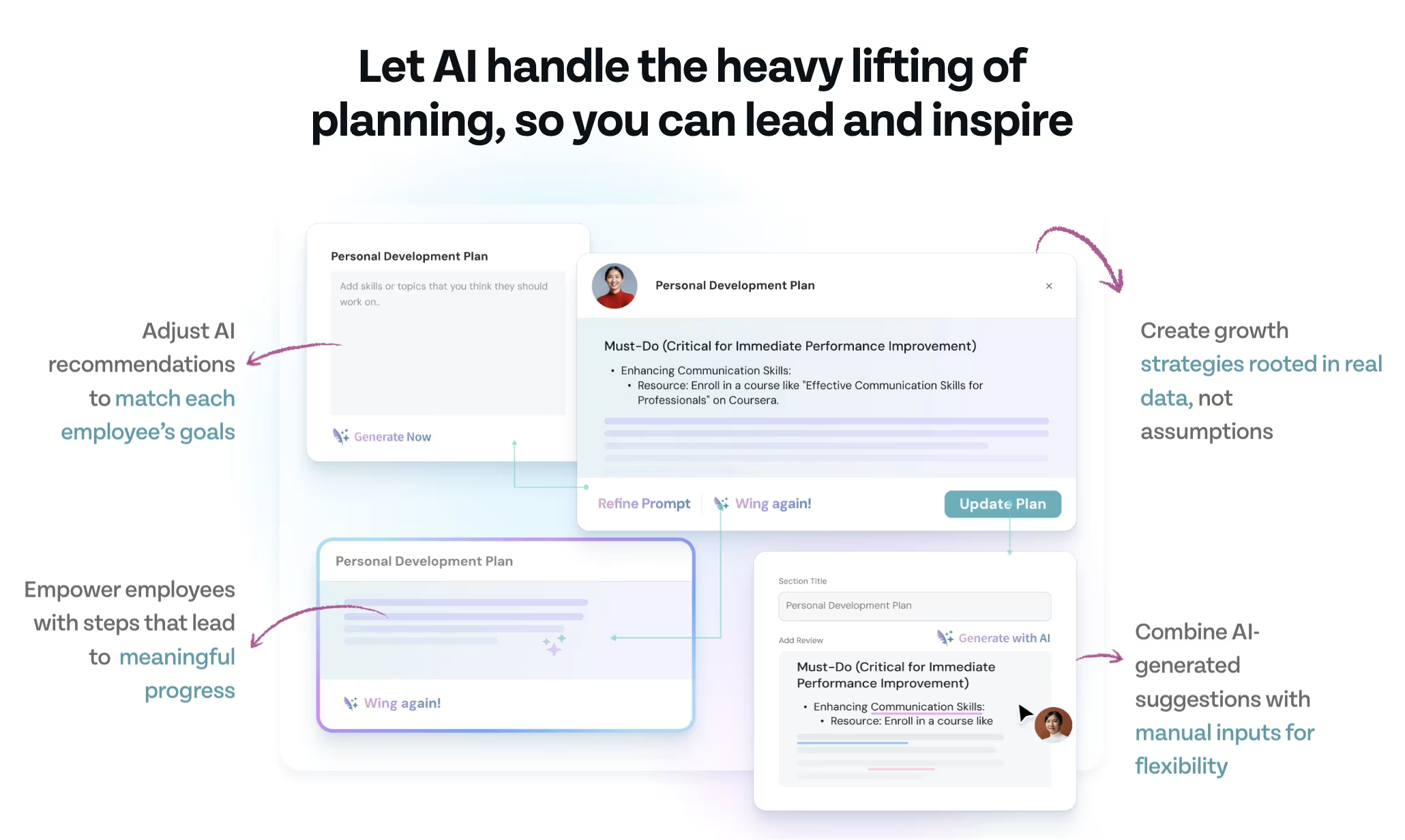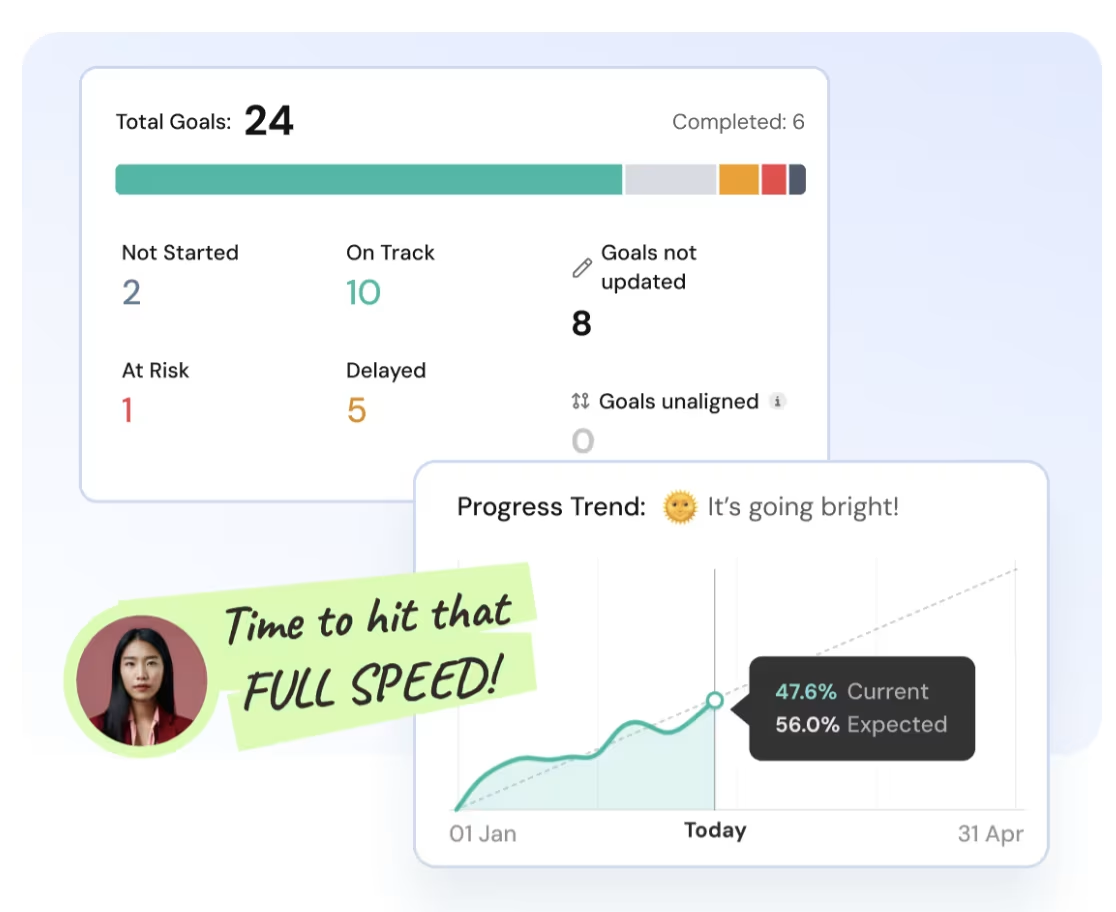You know that feeling when your annual performance review rolls around? That mix of anxiety and frustration as you try to remember what you accomplished six months ago, while your manager flips through notes trying to recall specific examples of your work?
Yeah, you're not alone in dreading these conversations. The truth is, annual performance reviews just aren't cutting it anymore. Research shows that 95% of HR leaders feel dissatisfied with traditional review systems, and honestly, it makes perfect sense—by the time you're discussing that project from last spring, the feedback feels pretty useless.
That's where continuous performance management comes in. Instead of one big, stressful conversation per year, imagine having regular, meaningful check-ins where you actually get feedback you can use.
Companies making this switch see some impressive results: engagement jumps by nearly 40%, compared to those stuck with annual reviews.. And here's the good news—it's not too late to make this switch, no matter how entrenched your current system might feel.
In this guide, I'll walk you through exactly how to make this transition work for your organization.
The cultural shift from annual reviews to continuous feedback
The workplace has fundamentally changed, but many of our performance management practices haven't kept up. A 2023 study by Deloitte found that 58% of executives believe their current performance management approach drives neither employee engag ement nor high performance.
In fact, many employees and managers report that traditional review processes create anxiety, damage relationships, and decrease motivation rather than improving performance management process.
Why annual reviews feel outdated
Think about how work actually happens today. Projects launch and wrap up in weeks, not months. Team compositions change rapidly. Remote work means managers can't just observe performance by walking around the office. Yet we're still trying to capture all of this dynamic activity in one annual conversation.
The numbers reflect this disconnect: 66% of employees are genuinely dissatisfied with their performance reviews, and 65% don't think the assessment even relates to their actual job. When two-thirds of your workforce thinks your evaluation process is irrelevant, that's a pretty clear signal for change.
This is exactly why annual reviews feel so outdated. They're built for a workplace that moves slowly and predictably, but we're operating in an environment that demands agility and real-time adaptation.
How modern work demands real-time input
Today's work environment moves at a different pace. Remote and hybrid arrangements mean fewer casual interactions where feedback naturally happens. Projects pivot quickly based on market conditions. In this environment, waiting a full year to course-correct just doesn't make business sense.
That's why 38% of organizations have already moved to quarterly or monthly assessments. They're recognizing that continuous feedback enables better transparency, stronger morale, and faster problem resolution.
The role of trust and transparency
Here's something interesting: Gallup research shows that managers account for at least 70% of variance in employee engagement, highlighting just how crucial the direct manager relationship is for workplace success. This tells us something important—the strongest workplace relationships happen between managers and their team members.
Think about it: when employees trust their managers, they're more likely to be honest about challenges, ask for help when they need it, and actually engage with feedback.
But here's the problem with annual reviews—how can you build trust and transparency when you're only having one formal conversation per year? It's like trying to maintain a friendship by only talking once every twelve months. Regular check-ins create an environment where employees feel safe to share what's really going on, and managers can address issues before they become bigger problems.
That's why continuous feedback isn't just about better performance—it's about building the trust that makes everything else possible.
How continuous feedback improves engagement and growth
Instead of saving up feedback for one annual dump, continuous systems spread it throughout the year in digestible, actionable pieces. The impact is immediate and measurable.
1. Timely recognition and course correction
Remember the last time someone thanked you for great work? How did the timing affect how that recognition felt?
Recognition delivered promptly after achievement creates an immediate connection between your actions and the appreciation.
Gallup recommends recognizing employees at least once every seven days to maintain optimal engagement. This isn't about constant praise—it's about acknowledging good work while it's still fresh in everyone's mind. Employees who receive this kind of timely recognition are twice as likely to stay with their organization.
2. Personalized development plans
Regular conversations naturally reveal individual growth opportunities. When you're talking with someone monthly instead of annually, you start to understand their career aspirations, learning preferences, and skill gaps in much greater detail.
According to LinkedIn's Workforce Learning Report, 94% of employees would stay at a company longer if it invested in their careers, making personalized development plans one of the most effective retention strategies available.
ThriveSparrow PDPs supports this by helping managers create customized development plans that track individual learning goals alongside performance objectives.

More importantly, employees who develop skills aligned with their personal interests are 46% more engaged. The connection is clear: when people see growth opportunities tailored to them, they're more invested in the work.
This is why continuous feedback creates such powerful development opportunities—it turns generic training into personalized growth journeys that employees actually want to pursue.
Try ThriveSparrow PDPs free for 14 days!
4. Increased motivation and retention
Here's where the business case becomes compelling. Organizations with highly engaged employees through continuous feedback systems experience 14.9% lower turnover rates and 24% higher productivity. [Source: Oak]. Companies with effective feedback cultures outperform competitors by approximately 20% in profitability.
The psychology makes sense. When people understand how they're performing and what they need to improve, they feel more in control of their success. This sense of agency directly translates to higher motivation and stronger commitment to the organization.
That's the real power of continuous feedback—it's not just about replacing annual reviews, it's about creating an ongoing conversation that helps people grow, feel valued, and actually enjoy coming to work.
How to Build a continuous performance management system
Once you understand why continuous feedback works, the next question is obvious: how do you actually build a system that delivers results without overwhelming everyone? Let's break this down into practical steps that actually work.
1. Setting SMART and cascading goals
Here's the thing about SMART goal setting—most organizations get it wrong because goals exist in isolation. Your marketing team doesn't know how their campaigns connect to the sales team's targets, and individual contributors have no idea how their daily work impacts the company's bigger picture.
Start with leadership setting 3-5 overarching organizational goals. Think revenue growth, customer satisfaction scores, or market expansion—big-picture stuff that everyone can understand. Then comes the crucial part: translating these down through each department and eventually to individual contributors.
The SMART framework keeps everyone focused:
- Specific: "Increase customer retention" becomes "Reduce churn rate by implementing two new retention strategies"
- Measurable: Attach concrete numbers—"Improve retention by 15%" not "improve retention"
- Achievable: If your team historically improves retention by 5% annually, aiming for 50% is setting them up to fail
- Relevant: Each goal should clearly connect to those bigger organizational objectives
- Time-bound: "By Q3" gives urgency; "eventually" doesn't motivate anyone
The magic happens when everyone can see how their individual goals feed into team goals, which support department goals, which drive company success. Suddenly that marketing campaign isn't just about clicks—it's about supporting the customer acquisition goal that enables the revenue target.
So, this is how you take a big project or task and manage performance throughout, rather than waiting for a year to talk about project changes, performance, feedback, or updates.
2. Using regular check-ins to stay aligned
Forget about lengthy monthly meetings that turn into status updates. Weekly 30-minute check-ins keep everyone aligned without becoming a burden.
Here's a format that actually works:
1. Opening (5 minutes): Quick priority updates
"What are your top three priorities this week?" This isn't about detailed project updates—it's about ensuring focus.
2. Key discussion (15 minutes): Focus on alignment needs and roadblocks
This is where real problems get solved. "I'm stuck waiting for legal approval" becomes "Let me connect you with Sarah in legal who can fast-track this."
3. Action items (5 minutes): Assign responsibilities with deadlines
Every problem needs an owner and a deadline. "I'll follow up with IT by Friday" creates accountability.
4. Closing (5 minutes): Reflection and improvements for next time
"What would make next week more productive?" This continuous improvement mindset prevents the same issues from recurring.
The key is consistency. These check-ins prevent goal drift and catch challenges before they become major obstacles. When someone's struggling, you find out within a week, not later during a quarterly review.
3. Incorporating 360-degree feedback
Traditional performance reviews only capture your manager's perspective. But think about it—your peers see how you collaborate, your direct reports experience your leadership style, and you understand your own challenges better than anyone else.
360-degree feedback gathers input from peers, direct reports, supervisors, and self-assessment. This provides a complete picture instead of one person's viewpoint.
Here's the critical principle:
Set up feedback cycles quarterly or bi-annually. Use structured questions like "What should this person continue doing?" and "What should they start doing differently?" These open-ended questions generate actionable insights rather than just ratings.
4. Using performance management software
Manual tracking becomes impossible as your team grows. Spreadsheets break down when you're managing goals for 50+ people across multiple departments.
Look for platforms with these essential features:
- Collaborative goal setting: Everyone can see how their goals connect to others
- Real-time feedback capabilities: Easy ways to give and receive input without formal processes
- 360-degree feedback tools: Streamlined collection from multiple sources
- Visual performance dashboards: At-a-glance progress tracking
The right software eliminates surprises during formal review periods because employees can see their progress continuously. No more "How am I doing?" conversations—the data shows exactly where things stand.
Explore our latest blog on: Top 12 Best Performance Management Software of 2025.
5. Training and upskilling managers
Here's an uncomfortable truth: most managers were promoted for technical skills, not people management abilities. Your best salesperson becomes a sales manager, but selling and managing salespeople require completely different skill sets.
Invest in comprehensive training covering:
- Feedback delivery: How to give constructive criticism that motivates rather than deflates
- Active listening: Really hearing what employees are saying, not just waiting to respond
- Coaching techniques: Helping people find solutions rather than always providing answers
Explore our latest blog on: How to Give Constructive Feedback? Examples and Tips
Effective programs emphasize preparation before delivering feedback. Managers learn to gather specific examples, plan the conversation structure, and anticipate employee reactions. They develop emotional intelligence for difficult conversations—how to address performance issues without damaging relationships.
Most importantly, provide opportunities to practice through real-world scenarios. Role-playing exercises help managers build confidence before high-stakes conversations.
6. Creating a feedback-first culture
Culture change starts at the top. When leaders consistently ask for feedback and demonstrate they can receive it well, it normalizes the process for everyone else.
Picture this: your CEO regularly asks "What should I do differently?" in team meetings and actually implements suggested changes. Suddenly, feedback stops feeling like criticism and starts feeling like collaboration.
Explore or latest blog on: How to Give Your Manager Feedback the Right Way
The comfort level with feedback increases with frequency. When input becomes standard operational practice rather than a special event, people stop approaching it with anxiety. Regular feedback feels normal; annual feedback feels like judgment.
Start small. Encourage managers to ask "How can I better support you?" during one-on-ones. Celebrate when someone shares constructive feedback openly. Share stories about how feedback led to positive changes.
7. Reviewing and updating goals regularly
Business conditions change rapidly. The marketing strategy that made sense in January might be completely wrong by June due to market shifts, competitive actions, or internal resource changes.
Performance management systems must remain flexible to stay effective. Goals should be easily updated to allow teams to respond to changing business conditions.
Combine scheduled goal reviews (quarterly works well) with informal discussions that any employee can initiate when needed. Maybe someone discovers their project timeline is unrealistic, or new priorities emerge that change their focus. They shouldn't have to wait three months to adjust course.
Make goal updates collaborative, not punitive. When someone needs to change their goals, it's usually because they've learned something important about the business or their role. That's valuable insight, not failure.
8. Celebrating wins and sharing success stories
Recognition creates momentum. When you celebrate achievements as they occur, you reinforce the behaviors that drive success while they're still fresh in everyone's mind.
Create natural opportunities to recognize achievements as they occur. Some companies establish dedicated "Performance Days" where task-related meetings pause and conversations focus exclusively on performance and recognition.
Share success stories that connect individual achievements to broader organizational wins. "Sarah's customer retention strategy contributed to our 20% revenue growth this quarter" shows exactly how individual work impacts company success.
This celebration approach builds a positive environment that reinforces the value of the continuous feedback system. People start looking forward to performance conversations instead of dreading them.
9. Sustaining the new system over time
Launching a continuous performance management system is just the beginning. The real challenge is maintaining momentum when the initial enthusiasm fades.
Companies that effectively implement these systems experience 15-20% lower employee turnover rates. But those results only come with consistent execution over time.
Create accountability systems for managers. Track whether check-ins are happening regularly, if feedback is being delivered constructively, and whether goal updates are keeping pace with business needs.
Measure what matters: employee engagement scores, goal completion rates, feedback frequency, and retention numbers. These metrics show whether your system is actually working or just creating busy work.
Most importantly, keep refining based on what you learn. The best continuous performance management systems evolve continuously themselves, adapting to what works best for your specific organization and culture.

Implementing with ThriveSparrow: A Practical Approach
Understanding the framework is one thing—actually implementing it is another. Here's how organizations typically use ThriveSparrow to support their transition to continuous performance management.
1. Goal Alignment and Tracking
ThriveSparrow goals offers goal management capabilities that connect individual objectives to organizational priorities. The platform provides visual progress tracking with various metrics, helping teams maintain visibility into goal completion without constant status meetings.
Organizations report that having centralized goal tracking reduces the administrative burden of performance management while improving alignment across teams.
.avif)
2. Feedback Collection Systems
The platform supports ongoing feedback through multiple channels, including peer recognition tools and structured review cycles. ThriveSparrow's 360-degree feedback module allows organizations to gather input from various sources using customizable templates.
Many teams find that having a structured system for feedback collection makes the transition from annual reviews more manageable for both managers and employees.
3. Performance Analytics
ThriveSparrow provides analytics that help organizations understand engagement patterns and performance trends. These insights can inform decisions about management approaches and identify areas where additional support might be needed.
The reporting features help track the effectiveness of continuous performance management initiatives over time.

4. Integration and Adoption
The platform integrates with common workplace tools like Slack, gusto, bob, Namely and Microsoft Teams... which can ease adoption challenges. Organizations typically start with one department or team before expanding the system company-wide.
Taking the Next Step
Transitioning to continuous performance management requires the right combination of strategy, tools, and commitment. Whether you choose ThriveSparrow or another platform, the key is starting with a clear implementation plan and realistic expectations.
Consider beginning with a pilot program in one department to test your approach before rolling it out organization-wide. Most importantly, remember that technology is just one piece—success ultimately depends on building a culture that values ongoing development and regular communication.
Ready to explore your options? Research different performance management platforms, request demos, and involve your team in evaluating which solution best fits your organizational needs and culture.
If you're considering ThriveSparrow for your implementation, they offer a 14-day free trial that lets you test their goal tracking, feedback systems, and analytics features without commitment. This gives you a risk-free way to see how continuous performance management might work in your specific environment.
FAQs
Q1. What are the key benefits of transitioning to continuous performance management?
Continuous performance management increases employee engagement by nearly 40% and performance by 26%. Organizations implementing this approach experience lower turnover rates, higher productivity, and employees who are 3.6 times more motivated than those receiving only annual feedback.
Q2. How often should feedback be given in a continuous performance management system?
Research shows that meaningful feedback should be given weekly for optimal results. 80% of employees who receive weekly feedback are fully engaged, compared to only 20% when feedback is delayed or non-existent. At minimum, recognize employees at least once every seven days.
Q3. What are some effective strategies for implementing continuous performance management?
Key strategies include setting SMART cascading goals, conducting structured regular check-ins, incorporating 360-degree feedback for development, and leveraging performance management software. It's also crucial to train managers in feedback delivery and create a feedback-first culture.
Q4. How does continuous performance management differ from annual reviews?
Unlike annual reviews that provide feedback once a year on past events, continuous performance management involves ongoing conversations about current work and future growth. It allows for timely course corrections, reduces anxiety, and creates transparency that's aligned with modern workplace pace and flexibility.
Q5. What impact does continuous performance management have on employee retention?
Organizations with effective continuous performance management systems experience 14.9% lower turnover rates. Employees who receive timely recognition are twice as likely to stay with their organization, and companies supporting professional development through continuous feedback see significantly lower likelihood of employees seeking jobs elsewhere.
















